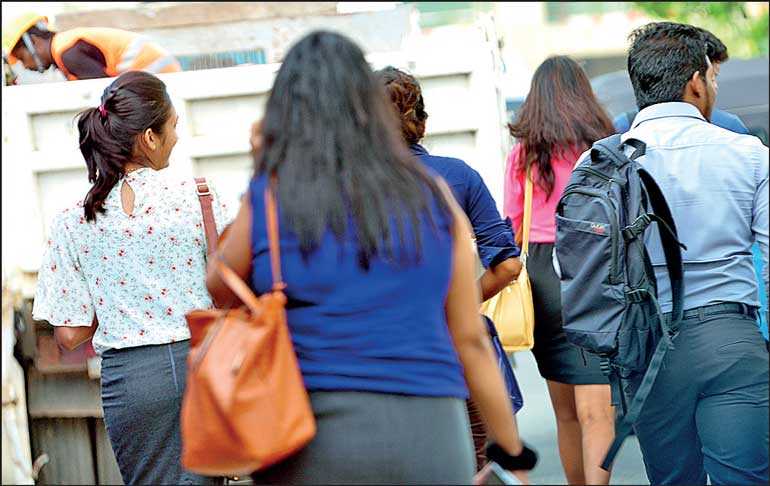Monday Dec 08, 2025
Monday Dec 08, 2025
Friday, 27 November 2020 00:00 - - {{hitsCtrl.values.hits}}

Many women are made to face obstacles in their daily lives, which usually hinders their professional growth, which in turn compels them to drop out of the workforce – Pic by Shehan Gunasekara
The topic regarding gender equality and equity has been dominating the social and economic sphere globally and is one of those topics that requires the need to be highly addressed, especially where a  country’s development goals are concerned.
country’s development goals are concerned.
Firstly, what is gender equity and how does it differ from gender equality? Gender equality is no doubt discussed consistently and is currently being taken as an area that is explored extensively. Equality is encouraging more female participation in the workforce and leadership by enforcing policies and practices that will ensure women or men’s rights, responsibilities and opportunities will not depend on whether they are born male or female.
Gender equity can be described as the means of achieving the goal of equality. However, there lies the challenge of maintaining equity and in maintaining fairness for both these segments. So, if equity is achieved, it would then lead to equality.
In 2019, the World Bank’s development indicators reported a female population at a little over 52% in Sri Lanka. When it comes to female participation in university study, especially with women who have graduated in 2018, this figure was recorded to be at quite a high number; standing at 67.8% when compared to that of men, which stood at 32.3% at state universities, as at 2018. These figures were determined at a Tracer Study of Graduates, which was instigated in collaboration with UNESCO and the UGC.
Even though the country sees a higher percentage of women being accepted into universities and graduating, this does not seem to reflect positively on the aspect of women being absorbed into top leadership positions, especially when it comes to policy making positions in Parliament. There is an evident divide in this equation where we can witness the drop in numbers of women in the workforce, and especially with regards to holding higher positions in today’s economy.
According to the report ‘Power of Parity: Advancing women’s equality in Asia Pacific’ by McKinsey & Company, Sri Lanka is capable of adding $ 20 b to GDP by the year 2025 by advancing gender equality gaps in the country. Whilst this prediction may have been done prior to the impact of the pandemic, the logic still stands.
Although the female workforce in Sri Lanka contributes extensively to the nation’s GDP, this is mainly achieved through their involvement in labour intensive roles spanning migrant workers and sectors such as apparels and tea. Women who travel abroad as migrant workers or engage in the apparels and tea sectors dominate their presence in these industries and contribute to the country’s GDP growth.
In 2018, the apparel sector for instance, which utilises a large number of female workers, brought in an inflow of around $ 5.3 b in export revenue. The tea sector contributed 1.2% to the GDP and accounted for 15% of total exports in 2018. Remittances by migrant workers are also an important foreign exchange earning source and amounts to approximately 9% of the GDP. In 2017, private remittances alone measured up to $ 7.19 b.
There is however, room for improvement when considering more knowledge-based segments such as in science and engineering for instance. Many women are made to face obstacles in their daily lives, which usually hinders their professional growth, which in turn compels them to drop out of the workforce. This could be due to family commitments, child care or even the lack of moral support from their nearest and dearest.
It is important to identify these gaps and to invest in these areas where women would receive the right amount of support, which would ensure that they receive the opportunity and ability to get the best out of them. When this is overlooked, the best minds and well-educated resources of this country would simply go to waste.
Among the steps that can be taken to ensure that this gap is narrowed down and that women are encouraged to continue working, is, for example, to provide better quality and regulated child care facilities for working mothers. Strategies that address such barriers are observed well in other developed countries and allow women with the ability to work and be productive in their roles while they enjoy peace of mind.
Creating a high-quality and standardised child-care system in the country will also create new opportunities for experienced and skilled women, thus retaining a portion of migrant worker population within the country, which will positively impact their families and local community. This is just one example to begin with.
Another instance is encouraging businesses and industries to embrace more women and absorb them into their workforce, especially those who are underutilised, or those who had not received the opportunity to propel forward in their professional lives, to work through shift-based jobs, remote working options, etc. Alongside this, recognising the passions that women have in terms of entrepreneurship and supporting them towards realising their visions is also a good way forward.
SLIM has recognised the importance of women entrepreneurship and this is what prompted the instigation of ‘Liyaka Mahima’, which was an event aimed at empowering home-based women entrepreneurs. SLIM had recently conducted this event to provide 70 female entrepreneurs with a platform where they could showcase their products and encourage them to pursue a ‘post-COVID-19’ business goal.
(The writer is Vice President Events – SLIM.)
Sources: